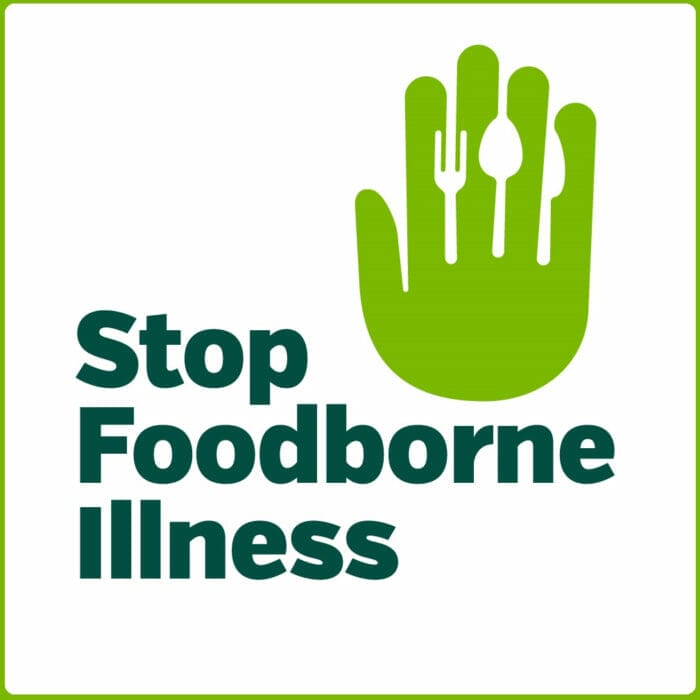Salmonella poisoning is the
most frequently reported cause of foodborne illness.
Salmonella-contaminated food may not look or smell spoiled.
2016 CDC/Alissa Eckert - Medical Illustrator
Salmonella poisoning is the most frequently reported cause of foodborne illness. Two types, Salmonella Enteritidis and Salmonella Typhimurium, are the most common in the United States and account for half of all human infections. Food contaminated with Salmonella may not look or smell spoiled. Consumption of food contaminated with these bacteria may cause salmonellosis, a foodborne illness.
Salmonella is a gram-negative, rod-shaped bacterium that can cause diarrheal illness in humans. They are passed from the feces of people or animals to other people or other animals.
For over 100 years Salmonella germs have been known to cause illness. They were discovered by an American scientist named Daniel E. Salmon, for whom they are named.
The Salmonella family includes over 2,300 serotypes of bacteria which are one-celled organisms too small to be seen without a microscope.
Most people experience diarrhea, abdominal cramps, and fever within 6 to 72 hours after the contaminated food was eaten. Symptoms usually begin six hours to six days after infection and last four to seven days.
Additional symptoms may be chills, headache, nausea and vomiting that can last up to seven days.
Salmonella strains sometimes cause infection in urine, blood, bones, joints, or the nervous system (spinal fluid and brain), and can cause severe disease.
CDC estimates Salmonella bacteria cause about 1.35 million infections, and 26,500 hospitalizations in the United States every year. Food is the source for most of these illnesses.
Children are the most likely to get salmonellosis.
Determining that Salmonella is the cause of the illness is based on laboratory tests that can identify Salmonella in the stool of an infected person. Once Salmonella has been identified, further testing can determine its specific type.
It is estimated that approximately 420 persons die each year with acute salmonellosis. Some strains are antibiotic resistant.
People can get Salmonella infection from a variety of sources, including:
Diagnosing Salmonella infection requires testing a specimen (sample), such as stool (poop) or blood. Testing can help guide treatment decisions.
Infection is diagnosed when a laboratory test detects Salmonella bacteria in stool, body tissue, or fluids. The test could be a culture that isolates the bacteria or a culture-independent diagnostic test (CIDT) that detects genetic material of the bacteria.
Salmonella infections can be life-threatening especially for infants, young children and pregnant women and their unborn babies.
Older adults and those with weaker immune systems (individuals living with HIV, cancer, diabetes, kidney disease, or transplant patients) are also at a higher risk for foodborne illness.
Persons with diarrhea usually recover completely, although it may be several months before their bowel habits are entirely normal.
A small number of persons with Salmonella develop reactive arthritis, which is characterized by joint pain, irritation of the eyes, and painful urination. It can last for months or years, and can lead to chronic arthritis which is difficult to treat.
Antibiotic treatment does not make a difference in whether or not the person develops arthritis. Other complications are aortic aneurysm within three months after infection and ulcerative colitis within one year after infection.
Most people recover without specific treatment. Antibiotics are typically used only to treat people with severe illness. Patients should drink extra fluids as long as diarrhea lasts. In some cases, diarrhea may be so severe that the person needs to be hospitalized.
In rare cases, infection may spread from the intestines to the bloodstream, and then to other parts of the body. In these people, Salmonella can cause death unless the person is treated promptly with antibiotics.
Past U.S. outbreaks of salmonellosis have been associated with meat products, poultry products, raw or undercooked eggs and dough, dairy products, fruits, leafy greens, raw sprouts, fresh vegetables, nut butters and spreads, pet foods and treats.
Any raw food of animal origin (such as meat, poultry, milk and dairy products, eggs, seafood), and some fruits and vegetables may carry Salmonella bacteria. The bacteria can survive to cause illness if meat, poultry, and egg products are not cooked to a safe minimum internal temperature as measured with a food thermometer. With fruits and vegetables, it is imperative that they are thoroughly washed.
Safe food handling practices are necessary to prevent bacteria on raw food from causing illness. Salmonella can cause foodborne illness (salmonellosis) through cross-contamination, e.g., when juices from raw meat or poultry come in contact with ready-to-eat foods, such as salads.
Food may also become contaminated by the unwashed hands of an infected food handler who might or might not be showing symptoms.
In the event that retailers and/or other food service operators are found to have handled recalled or other potentially contaminated food in their facilities, they should:
Consumers should follow these steps:
A new nationwide poll of 1,000 registered voters reveals incredibly high support for stricter regulations on poultry production aimed at reducing Salmonella poisoning and other illnesses.




Stop Foodborne Illness, together with coalition partners CSPI, CFA and Consumer Reports, as well as STOP constituent advocates petition the USDA/FSIS (Food Safety Inspection Service) to establish enforceable poultry standards.

Meanwhile, my wife, in the other room, had no idea what was going on. In fact, she thought that I had been rather rude and was gradually getting angry that I had not come out to tell her about my interviews, and say hello to her mother!
Within 30 minutes … I no longer had the strength to stand. I had a brief pause, and found myself lying on the floor of the bathroom. Covered in vomit and diarrhea, I reached into the pocket of my pants, pulled out my phone and texted “help” to my wife.

Stop Foodborne Illness is a 501(c)(3) tax-exempt organization. Donations are tax-deductible to the extent the law allows.